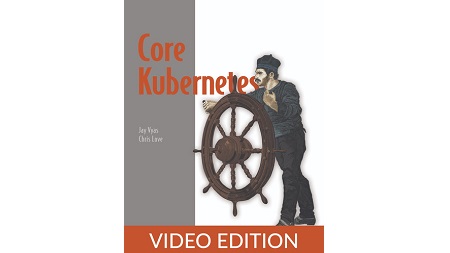
English | MP4 | AVC 1280×720 | AAC 44KHz 2ch | 77 Lessons (11h 44m) | 1.70 GB
Take a deep dive into Kubernetes inner components and discover what really powers a Kubernetes cluster. This in-depth guide shines a light on Kubernetes’ murky internals, to help you better plan cloud native architectures and ensure the reliability of your systems.
In Core Kubernetes you will learn about:
- Kubernetes base components
- Kubernetes networking
- Storage and the Container Storage Interface
- External load balancing and ingress
- Kubernetes security
- Different ways of creating a Kubernetes cluster
- Configuring Kubernetes to use a GPU
To build and operate reliable Kubernetes-based systems, you need to understand what’s going on below the surface. Core Kubernetes is an in-depth guide to Kubernetes’ internal workings written by Kubernetes contributors Chris Love and Jay Vyas. It’s packed with experience-driven insights and advanced techniques you won’t find anywhere else. You’ll understand the unique security concerns of container-based applications, minimize costly unused capacity, and get pro tips for maximizing performance. Diagrams, labs, and hands-on examples ensure that the complex ideas are easy to understand and practical to apply.
Real-world Kubernetes deployments are messy. Even small configuration errors or design problems can bring your system to its knees. In the real world, it pays to know how each component works so you can quickly troubleshoot, reset, and get on to the next challenge. This one-of-a-kind book includes the details, hard-won advice, and pro tips to keep your Kubernetes apps up and running.
This book is a tour of Kubernetes under the hood, from managing iptables to setting up dynamically scaled clusters that respond to changes in load. Every page will give you new insights on setting up and managing Kubernetes and dealing with inevitable curveballs. Core Kubernetes is a comprehensive reference guide to maintaining Kubernetes deployments in production.
What’s Inside
- Kubernetes base components
- Storage and the Container Storage Interface
- Kubernetes security
- Different ways of creating a Kubernetes cluster
- Details about the control plane, networking, and other core components
Table of Contents
1 Why Kubernetes exists
2 Containers and images
3 Kubernetes features
4 Kubernetes components and architecture
5 Why the Pod
6 What is a Pod
7 The Node API object
8 Creating a web application with kubectl
9 Infrastructure controllers
10 Scaling, highly available applications, and the control plane
11 Let’s build a Pod
12 What is a Linux primitive
13 Files are composable
14 Using Linux primitives in Kubernetes
15 Exploring the Pod’s Linux dependencies
16 Building a Pod from scratch
17 Securing our process with unshare
18 Using our Pod in the real world
19 Using the kube-dns Pod
20 Using cgroups for processes in our Pods
21 Processes and threads in Linux
22 Implementing cgroups for a normal Pod
23 Diving into how the kubelet manages resources
24 Hack Editing HugePages with init containers
25 Monitoring the Linux kernel with Prometheus, cAdvisor, and the API server
26 Creating a local Prometheus monitoring service
27 CNIs and providing the Pod with a network
28 Implementing the service side of the Kubernetes SDN The kube-proxy
29 What about NodePorts
30 Diving into two CNI networking plugins Calico and Antrea
31 Installing the Calico CNI provider
32 Kubernetes networking with OVS and Antrea
33 Troubleshooting large-scale network errors
34 Inspecting CNI routing on different providers with the arp and ip commands
35 Routes
36 The kube-proxy and iptables
37 Ingress controllers
38 Pod storage and the CSI
39 Three types of storage requirements for Kubernetes
40 The container storage interface (CSI)
41 A quick look at a few running CSI drivers
42 Storage implementation and modeling
43 PersistentVolumes
44 Dynamic provisioning benefits from CSI but is orthogonal
45 Kubernetes use cases for storage
46 hostPath for system control andor data access
47 Cassandra An example of real-world Kubernetes application storage
48 Running Pods How the kubelet works
49 The core kubelet
50 Starting the kubelet binary
51 The Container Runtime Interface (CRI)
52 DNS in Kubernetes
53 Why StatefulSets instead of Deployments
54 The resolv.conf file
55 The core of the control plane
56 Scheduler details
57 The controller manager
58 etcd and the control plane
59 Knowing when to tune etcd
60 etcd as a data store
61 Looking at the interface for Kubernetes to etcd
62 The CAP theorem
63 Performance and fault tolerance of etcd at a global scale
64 Container and Pod security
65 Container security
66 Pod security
67 Pod Security Policies (PSPs)
68 Nodes and Kubernetes security
69 Isolated container runtimes
70 API server security
71 Authn, Authz, and Secrets
72 Network security
73 Multi-tenancy
74 Installing applications
75 Installing the Carvel toolkit
76 Part 3 Managing and deploying Guestbook as a single application
77 Revisiting the Kubernetes Operator
Resolve the captcha to access the links!